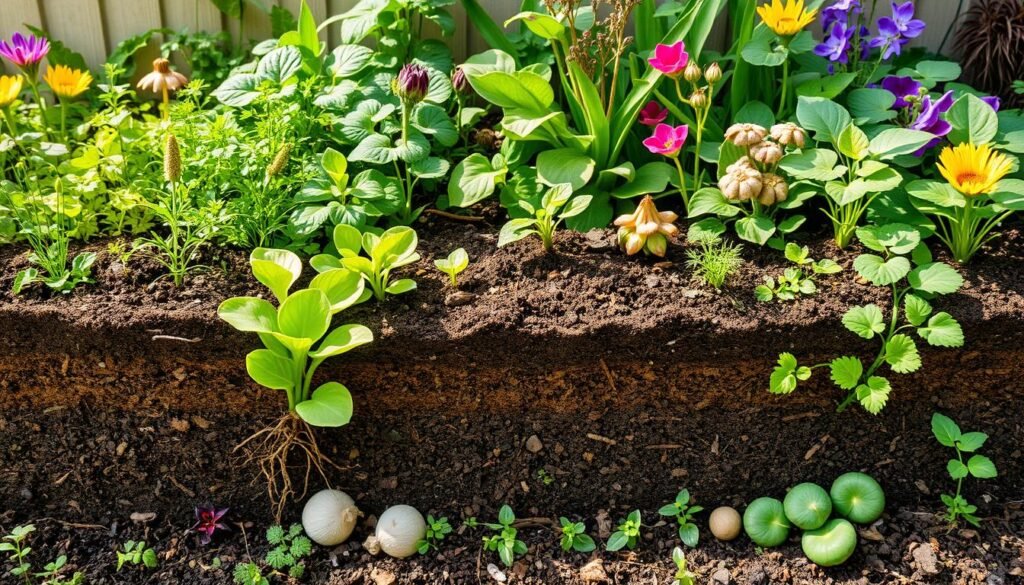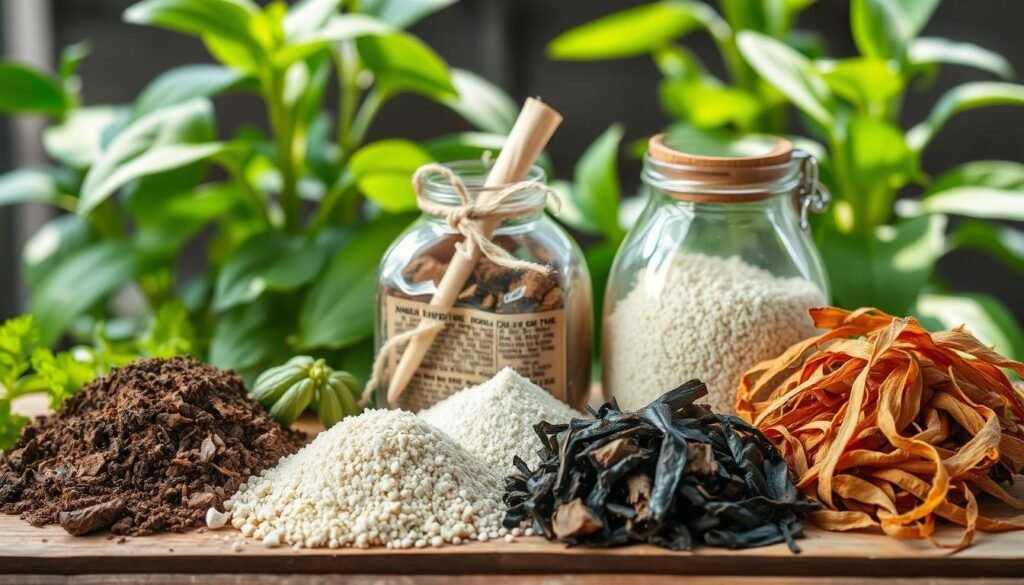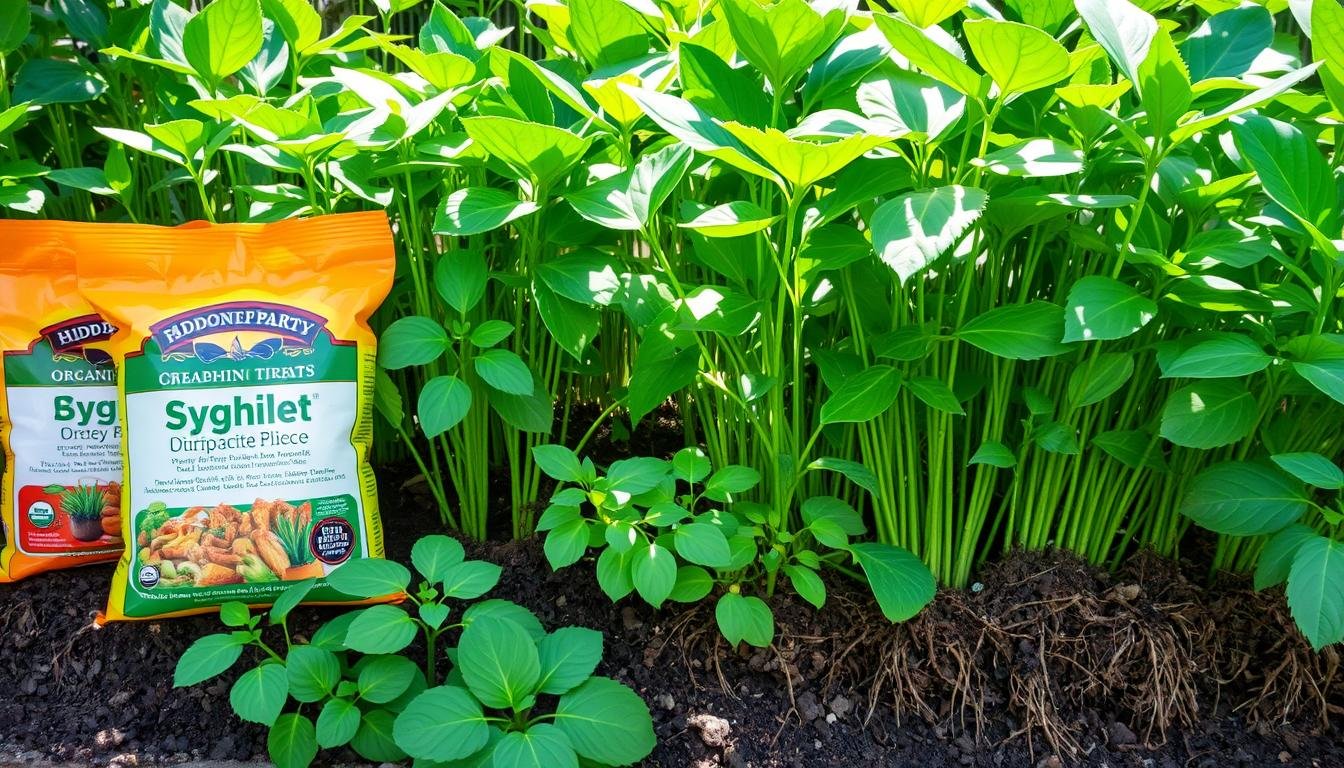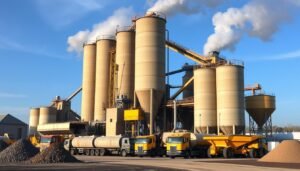Welcome to your ultimate resource for plant fertilizer. Here, you’ll learn about the key elements that boost garden growth. For home gardeners, knowing about nutrient-rich soil amendments is vital. It helps create vibrant gardens and abundant harvests.
Plants need 17 essential nutrients to grow well. These include nitrogen, phosphorus, and potassium. It’s important to provide the right balance of these nutrients. This guide will cover fertilizers, their makeup, how to use them, and the benefits of organic fertilizers over others. Whether you’re new to gardening or have experience, you’ll find useful tips to improve your gardening skills.
Table of Contents
Understanding Nutrient Needs of Plants
Plants need many nutrients to grow well. Knowing what they need is key for a healthy garden. There are 17 essential nutrients, including nitrogen, phosphorus, and potassium. These are important for growth. Other nutrients, needed in smaller amounts, are also vital for health.
The 17 Essential Nutrients for Plant Growth
The list includes carbon, hydrogen, and oxygen from air and water. Then there are the primary macronutrients: nitrogen, phosphorus, and potassium. Secondary macronutrients like calcium, magnesium, and sulfur are also important. Plus, there are micronutrients like boron, copper, and iron. Knowing what your plants need is important; without it, they won’t grow well.
Macronutrients vs. Micronutrients
Macronutrients like nitrogen, phosphorus, and potassium are needed in large amounts. Nitrogen helps leaves grow, phosphorus aids in energy and root growth, and potassium makes plants strong. Micronutrients, though needed in small amounts, are just as important. They work together with macronutrients for the best plant health.
Choosing the right fertilizer is easier when you understand nutrient needs. Fertilizers have N-P-K ratios that help you know what nutrients you’re giving your plants. For more on growing hydroponic plants, check out this beginner’s guide to hydroponic plants.
The Importance of Soil Testing
Soil testing is key for home gardeners wanting to grow healthy plants. Knowing about nutrient availability and pH level helps keep the soil healthy. Tests give you the info you need to choose the right fertilizers for your garden.
Why Use Soil Tests?
Soil tests help find any nutrient gaps, pH imbalances, or too much salt. This is important before planting or during the growing season. It helps manage nutrients well and keeps the environment safe from too much fertilizer.
How to Conduct a Soil Test
To test your soil, start with a soil test kit made for gardening. Take samples two hours after fertilizing or on the same day. Make sure to take samples from different parts of your garden or greenhouse.
There are different ways to test soil, including:
| Testing Method | Description |
|---|---|
| 1:2 Dilution Method | A simple, effective on-site test for pH and soluble salts. |
| Saturated Media Extract (SME) | A widely used method for testing greenhouse media, requiring specialized skills. |
| Leachate Pour Thru | Continuous monitoring of pH and soluble salt levels without disturbing plants. |
After getting your test results, it’s important to understand them. This helps you find nutrient gaps and fix them. It improves your soil health and makes your garden more productive.

Do soil testing every 3-5 years, or more often if you change fertilizers. This keeps your garden healthy and productive. For more tips on managing nutrients, see this guide on nutrient management.
Factors Affecting Nutrient Availability
Nutrient availability in the soil is key for plant growth. Knowing about soil texture and pH is vital. These factors affect how well plants get the nutrients they need.
Soil Texture and Its Impact
Soil texture, whether clay or sandy, greatly impacts nutrient retention. Clay soil holds more water and nutrients than sandy soil. Sandy soil drains fast, needing more fertilization.
A mix of sand and clay in the soil is best. It improves water retention and aeration, helping nutrients reach plants better.
The Role of Soil pH
Soil pH affects nutrient availability for plants. Most crops grow best in a pH between 6.0 and 7.5. This range makes nutrients like nitrogen, phosphorus, and potassium accessible.
In acidic soils, some nutrients are toxic to plants. Alkaline soils limit phosphorus and micronutrients. Adjusting soil pH with lime or sulfur helps plants thrive.

Choosing the Right Plant Fertilizer
Choosing the right fertilizer is key to your plants’ health. Fertilizer labels show the N-P-K ratios, which tell you about nitrogen, phosphorus, and potassium. These numbers help you pick the best fertilizer for your plants, ensuring they grow well.
Understanding N-P-K Ratios
The N-P-K ratio is vital for gardeners. A 10-10-10 ratio means each nutrient is 10% of the fertilizer. Different plants need different nutrients. For example, bulbs like daffodils need more phosphorus for roots.
Lawns, on the other hand, do well with nitrogen-rich fertilizers. A 22-23-4 ratio is good for lawns because it has lots of nitrogen.
Granular vs. Water-Soluble Fertilizers
Granular and water-soluble fertilizers have their own benefits. Granular fertilizers release nutrients slowly, lasting weeks. They’re good for long-term feeding. They should have at least 15% slow-releasing nitrogen in some places.
Water-soluble fertilizers, on the other hand, provide quick nutrients. They’re great for fast-growing plants and container gardens. You need to apply them every week, mixing them with water and soil.

| Fertilizer Type | N-P-K Ratio | Application Frequency | Benefits |
|---|---|---|---|
| Granular Fertilizers | Variable (e.g., 10-10-10) | Every 4-6 weeks | Slow-release, less frequent application |
| Water-Soluble Fertilizers | Variable (e.g., 5-10-10) | Weekly | Quick release, ideal for container plants |
Knowing the differences between these fertilizers and their N-P-K ratios can greatly improve your gardening. It helps you make better choices when picking fertilizers.
Types of Fertilizers: Organic vs. Inorganic
Knowing the different types of fertilizers can really help your garden grow. Organic fertilizers come from natural sources, while inorganic ones are made in labs. Each has its own set of nutrients, benefits, and downsides to consider.
Benefits of Organic Fertilizers
Organic fertilizers, like compost teas and animal manures, are great for your garden. They make the soil healthier by adding structure and organic matter. This helps grow all kinds of plants and is good for the environment.
- Long-term soil benefits: Organic matter helps the soil hold water and nutrients better over time.
- Reduced risk of environmental harm: Organic fertilizers are less likely to pollute waterways than inorganic ones.
- Slow-release nutrients: Organic fertilizers release nutrients slowly, keeping plants healthy for longer.
Drawbacks of Inorganic Fertilizers
Inorganic fertilizers, like ammonium sulfate and ammonium phosphate, work fast because they have lots of nutrients. They mainly have nitrogen, phosphorus, and potassium but lack some important micronutrients.
- High nutrient concentration: Inorganic fertilizers give plants nutrients quickly, which is good for immediate needs.
- Potential environmental risks: Using them wrong can harm the soil and pollute waterways.
- Limited long-term effects: They don’t improve soil structure or build biomass like organic fertilizers do.
Thinking about what your plants need will help you pick the best fertilizer. Many gardeners mix organic and inorganic fertilizers for the best results. This way, they get quick nutrient release and also care for the environment. For more information, check out this detailed guide.

| Fertilizer Type | Examples | Nutrient Release Rate | Environmental Impact |
|---|---|---|---|
| Organic | Compost, Manure, Blood Meal | Slow | Eco-friendly, less runoff |
| Inorganic | Ammonium Phosphate, Urea | Rapid | Higher risk of nutrient runoff |
Methods of Applying Fertilizer
Knowing how to apply fertilizer is key for healthy plants. You can choose from broadcasting, band applications, and foliar sprays. Each method affects how well plants get the nutrients they need.
Broadcasting vs. Band Applications
Broadcasting spreads fertilizer evenly over the soil’s surface. It’s good for dense crops. This method ensures nutrients reach all parts of the soil.
Band applications, on the other hand, put nutrients right next to the roots. This is great for areas with low soil fertility. It helps plants grow stronger by giving them nutrients directly.
Foliar Sprays: An Alternative Application Method
Foliar sprays give nutrients straight to the leaves. They’re perfect for fixing micronutrient issues. Companies like Van Iperen International offer special foliar fertilizers for different crops.
Foliar sprays also help prevent nutrient waste. They’re more focused than other methods. Using them with fertigation can save water and deliver nutrients precisely.
Choosing the right method for your plants and garden is important. Learn more about fertilizing in this guide. The right application technique leads to healthy, strong plants.
Common Nutrient Deficiencies in Home Gardens
Knowing the signs of nutrient deficiencies can really help your garden grow. Spotting these problems early lets you fix them and keep your plants healthy. Different nutrients affect plants in different ways, so it’s key to know how to spot these issues.
Identifying Nitrogen Deficiency
Nitrogen deficiency shows up as yellowing lower leaves and weak branches. It can also lower crop yields, which is clear in early spring. To keep an eye on nitrogen levels, get your soil tested regularly. If you see these signs, it’s time to adjust your fertilizer.
The Effects of Phosphorus and Potassium Deficiency
Phosphorus deficiency makes leaves dark green with a purple tint and stunted growth. You might see brown spots too. On the other hand, potassium deficiency causes brown leaf edges and yellow spots between veins. Both can slow down plant growth and need quick action with the right fertilizer.
For those wanting to learn more, identifying nutrient deficiency in plants is a great resource. Keeping the right pH and nutrient balance is vital. Adding compost can also help with nutrients and soil health.
General Guidelines for Fertilizer Use
Using fertilizers in your garden needs careful planning. Knowing when and how much to apply is key. This knowledge helps your plants grow strong and healthy.
When to Fertilize Your Plants
Fertilize when your plants are growing the most. Spring is usually the best time for most plants. This is when perennials and annuals do well.
Vegetables need more food as they grow. But, be careful not to fertilize too early or too late. Indoor plants need a special liquid food every month to grow well.
Application Rates and Techniques
It’s important not to over-fertilize. Too much can hurt your plants. For vegetables, start with 2 lbs. of nitrogen for every 1,000 square feet.
Use specific advice for different vegetables. There are many ways to apply fertilizer, like broadcasting or foliar application. Choose the best method for your plants.
| Crop Type | Nitrogen Requirement per 1,000 sq. ft. | Recommended Fertilizer Type |
|---|---|---|
| Leafy Greens | 3 lbs. | Granular Fertilizers (slow-release) |
| Trees and Shrubs | 2 lbs. | Granular Fertilizer (balanced) |
| Indoor Potted Plants | Monthly | Water-soluble Fertilizers |
| Bulbs | Late Fall | Granular Fertilizers |
By following these tips, your garden will flourish. Regular soil tests help keep your plants healthy and productive for a long time.
Conclusion
Effective fertilization is key to a healthy garden. Knowing what your plants need, testing the soil, and using fertilizers right are essential. These steps help your garden grow well and care for the earth.
Choosing the right fertilizer is important. Look at what your plants need, like macronutrients and micronutrients. Too little phosphorus can slow growth. But the right amount helps plants grow strong.
Being a good gardener means making smart choices about fertilizers. Use sustainable practices and watch how your garden grows. Give your plants the right nutrients to make your garden beautiful all year.



